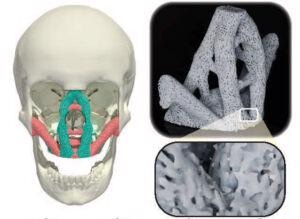Material created from a Princeton University’s research laboratory has holes — but that is not a bad thing. Engineered to imitate wood, bone and other natural materials, the porous materials are lighter than conventional items and can be advantageously implanted into structures to offer better stiffness in areas with high demand.
 The new materials could have applications for reconstructive surgery and other fields. Image Credit: Princeton University
The new materials could have applications for reconstructive surgery and other fields. Image Credit: Princeton University
These porous materials, developed by scientists at Princeton University and the Georgia Institute of Technology, comprise spinodal microstructures — networks of exclusively engineered holes that can be tweaked to accomplish enhanced behavior at the macro level.
In new research reported online in the March 16th issue of the journal Advanced Materials, the researchers integrated various realizations of these spinodal microstructures to develop and prototype facial implants for reconstructive surgery and sturdy, lightweight components for airplanes.
Professor of solid and structural mechanics at the University of Trento, Davide Bigoni, who was not involved with this study, termed the outcomes a “breakthrough.”
The authors have found a clever way to allow a continuous transition between zones with different architectures. This is the ultimate concept of biomimicking, as all natural structures form continuous systems. This is a fact known since ancient times—‘natura non facit saltus’—nature does not make jumps.
Davide Bigoni, Professor of Solid and Structural Mechanics, University of Trento
A number of natural materials, including wood, bone, animal horns and sand dollar skeletons, are filled with holes. The empty spaces make the materials lightweight, and in certain cases, enable body fluids to travel via the pores.
In bones, these spaces enable a remodeling process that renders the bone more or less dense in reaction to physical requirements. Developing artificial materials with analogous properties has been tough for scientists.
In the new research, the team imitated these natural materials by engineering microstructures with holes of various shapes, sizes and orientations. The new products are called architected materials that have tailored performance according to the relation of geometry and material. The shape of the holes can be like diamonds (bone), columns (wood), spheres (like the ones in sand dollar skeletons) or lentils (horn).
The team could infuse the material with stiffness in various directions by altering the shape. They regulated the density of the material by altering the holes’ size and orientation inside an object to boost stiffness in areas under strain.
You have the actual structure and the microstructure working together to get superior performance.
Fernando Vasconcelos da Senhora, Study First Author and Graduate Student, Georgia Institute of Technology
To exhibit potential applications, the scientists engineered and 3D-printed a facial implant, like the kind used to rectify a significant facial injury caused due to a car accident. At present, surgeons use titanium or plastic to develop porous implants that enable bone to regrow via holes, but these implants do not possess the same tunability attainable with spinodal architectures.
The scientists integrated sections with column- and lentil-shaped holes to develop an implant that was sufficiently rigid to endure the forces of chewing and had the appropriate size holes to boost bone growth and healing. The prototype implant was composed of a photopolymer resin; however, it could be 3D-printed using biocompatible materials for patients in the future.
The scientists said the method paves the way for developing implants with numerous types of materials because the blend of geometry and material enables engineers to tweak performance.
It’s not the base material that is better. It is the microscale features that are better. In theory, we could make the scaffolds out of any material—most appropriate would be to explore biocompatible materials.
Emily Sanders, Study Co-Author and Assistant Professor of Mechanical Engineering, Georgia Institute of Technology
To demonstrate a totally different use, the scientists integrated three kinds of microstructures to build a jet engine bracket — a vital part of an aircraft, which keeps the engine in place and must be robust as well as lightweight.
We have a technique that is quite powerful in the sense that it combines material architectures with optimization at different scales and its integration with additive manufacturing. It can have a broad range of applications in the sense that it scales, so it can be applied in nano- and microtechnology, as well as at meso- and macroscales.
Glaucio Paulino, Principal Investigator and Margareta E. Augustine Professor of Engineering, Princeton University
A core aspect of the materials’ success is the continuous transitions from one form of microstructure to another inside the same object. Suddenly swapping between microstructures without linking the network of pores would result in the material tearing along the seams. Materials composed of spinodal microstructures are also less likely to have fragile spots because the holes occur randomly, rather than in organized patterns.
“A major part was figuring out how to take advantage of the manufacturing platform and [work out] mathematically the structure of these architected materials and then link the two together so that we could actually fabricate something,” said Sanders.
The researchers are already investigating further uses for the microstructures. Presently, the innovation is in the prototype phase, but they are keen to test the features of the materials further.
“I’m interested in understanding the fundamental questions about how these architected materials behave,” Sanders said.
The study was supported partly by funding from the National Science Foundation.
Journal Reference:
Senhora, F. V., et al. (2022) Optimally-Tailored Spinodal Architected Materials for Multiscale Design and Manufacturing. Advanced Materials. doi.org/10.1002/adma.202109304.